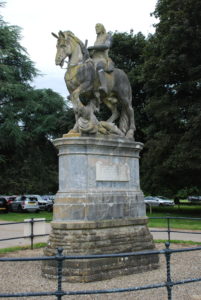
Two versions are known of a seventeenth-century fireback on which is portrayed an equestrian figure trampling a supine victim. The statue is mounted on a plinth on each side of which a ‘herb woman’ is seated with a basket of fruit or flowers. The pictorial panel is surrounded by a bead edging of arched rectangular or ‘Palladian’ shape, on each side of which stands a Solomonic column with trailing vine decoration, supporting a fillet-edged border surmounted by a crown between two reposing figures. On one of the two versions of this fireback, seen here on the right, are the letters ‘ƆC R’, with the ‘Cs’ interlocked, representing Charles II and his queen, Catherine of Braganza. The ‘R’ is significantly larger than the other letters, and is evidently from a different font stock, the letters probably having been impressed independently of the original design before casting.

The other version differs in that there is only one letter ‘C’, the plinth appears to be slightly smaller and in a different form, and it has the date, 1674 (with the 7 and 4 reversed), placed on the front of the plinth. Again the letters are from different font stocks and would have been separately impressed on the original casting. The proportions of the two firebacks differ slightly, the dated example being slightly narrower. Although in similar form to continental firebacks of the mid- to late-seventeenth century, their rather more squat proportions are different, and the scene has a quality which is more characteristic of some English firebacks. This is borne out when the source for the equestrian figure is known.

In the late 1660s Sir Robert Vyner, Bt., goldsmith, banker to Charles II and soon to be Lord Mayor of London, acquired an unfinished marble statue. Purchased from a stonemason’s in Leghorn (Livorno) in Italy, and originally intended as an equestrian statue of Jan Sobieski, the then commander of the Polish armies in their war against the Tatars, and who was crowned king of Poland in 1676. He was portrayed seated on a charger, riding down the figure of a Tatar or Turk. Shipping the statue to England, Vyner had the face of Sobieski altered by the sculptor Jaspar Latham to look like King Charles II, and the face of the Tatar changed to resemble that of Oliver Cromwell, albeit with the Tatar’s turban still in place. Vyner then had the statue erected on an 18-foot-high plinth in Stocks Market, Poultry, at the eastern end of Cheapside, on 29th October 1672. The erection of the statue was the subject of a satirical poem, ‘On the Statue in Stocks Market’ by Andrew Marvell, which drew attention to its less than flattering likeness to King Charles as well as to Sir Robert Vyner’s questionable motives in donating it. It continued to attract opprobrium, James Ralph, in his Critical Review of the public buildings, statues etc. in London in 1734 commenting that it was a thing “so ridiculous and absurd, it is not in one’s power to look upon it without reflecting on the taste of those who set it up”.

The statue stood in Stocks Market for 65 years until it was decided that the location should be redeveloped for the construction of a residence for the Lord Mayor. After some debate as to whether Leadenhall Market would be a better location, the statue was taken down on 17th March 1737/8* and, for want of anywhere else to put it, stored in a builder’s shed. The Mansion House was built in its place. This event also attracted some satirical verses, though this time they were anonymous. Sometime later an enterprising innkeeper re-erected the statue in his yard, until in 1779 the city corporation acceded to a request from Sir Robert Vyner’s great-nephew and namesake for its return. He had it transported to his seat at Gautby Hall in Lincolnshire, where it stood on an island in a lake until 1883, it then being removed to Yorkshire and installed in front of Newby Hall, near Ripon, which had come to the Vyner family by marriage, and where it remains to this day.
*In 1738 Britain was still using the Julian calendar in which New Years Day was 25th March, so 17th March in that year was regarded as still being in 1737.